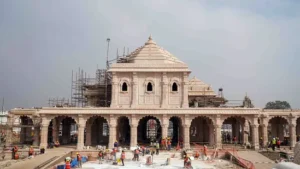The grand Ram Lalla temple in Ayodhya is not just a monument of faith, but a testament to architectural ingenuity and scientific marvels. Designed to stand strong for over a millennium, the temple boasts unique features that combine traditional knowledge with cutting-edge technology.
One striking aspect is the complete absence of iron and steel. Instead, the structure relies on high-quality granite, sandstone, and marble, joined together using a clever “lock and key” mechanism of grooves and ridges. This method not only enhances longevity, but also aligns with ancient temple construction practices.
Furthermore, the foundation is built on a solid rock-like base created by replacing unstable soil with compacted layers of engineered soil. This ingenious solution ensures earthquake resistance for a staggering 2,500 years!
Modern science comes into play through extensive computer modeling and the use of 21st-century building codes. This ensures both structural integrity and adherence to traditional Nagara style architecture.
The intricate details of the temple speak volumes of its dedication to craftsmanship. Over 160 intricately carved sandstone columns grace the ground floor, while the sanctum sanctorum is lined with gleaming white Makrana marble, reminiscent of the Taj Mahal.
The Ram Lalla temple is a powerful symbol of faith and tradition, but it also stands as a testament to India’s scientific prowess and commitment to preserving its architectural heritage. This unique blend of ancient wisdom and modern technology promises to ensure that the temple stands tall for centuries to come, a beacon of devotion and a tribute to India’s rich cultural tapestry.





















+ There are no comments
Add yours